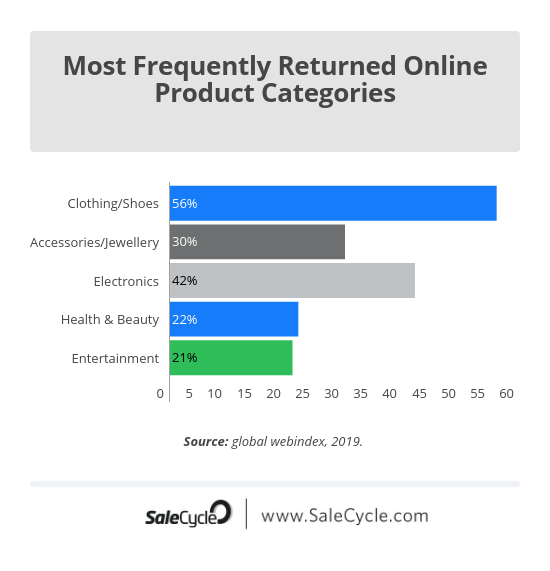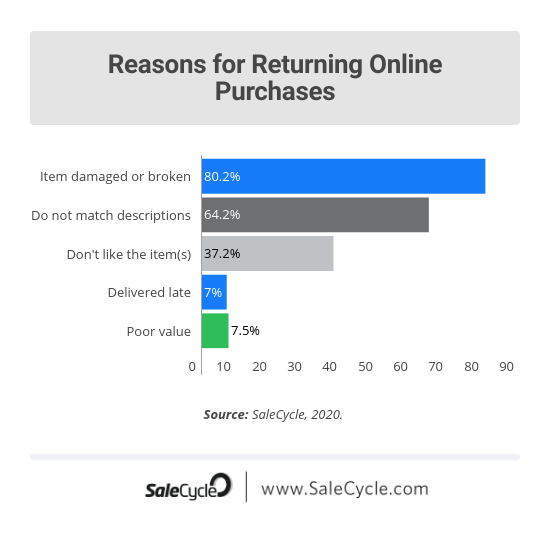We take a look at some key stats and trends around ecommerce returns.
Returns policies, and how returns are handled, are key concerns for online retailers.
Returns can be a major headache for retailers. There’s the cost of processing returns, in terms of staff and resources, and there’s also the risk that items returned may not be easily resold.
All of this has an effect on retailers’ profit margins, and some sectors suffer more than others. It’s a particular problem for online retailers, according to Paazl. While returns rates to stores are around 8%, this jumps to around 25% for items bought online.
Serial Returners
Barclaycard research looked at the issue of serial returners, shoppers who deliberately over-order so that they can keep the items they want and return the rest.
- 30% of shoppers deliberately over-purchase and subsequently return unwanted items.
- 19% admitted to ordering multiple versions of the same item so they could make their mind up when they’re delivered.
Effects of Returns for Retailers
The same Barclaycard survey also asked retailers how returns impact their business.
- 57% of retailers said that dealing with returns has a negative impact on the day-to-day running of their business.
- 33% of online retailers offer free returns but offset the cost of this by charging for delivery.
- 20% said they’d increased the price of products to cover the cost of returns.
Most Returned Product Categories
Fashion has the biggest issue with online returns, with health & beauty products the next most likely to be returned.


Reasons for Returning Online Purchases
Problems with delivery account for many returns, with items having to be returned after being damaged or broken, often in transit.
Another key reason was that items did not match descriptions or customer expectations, which suggests retailers have to work harder to provide information and product images, so that customers are making more informed purchase decisions.


Poor Returns Experiences
Some retailers may look to reduce returns rates by placing obstacles in front of customers, perhaps charging for return postage, or making it harder to return items.
However, the risk is that you can alienate customers – a survey from Rebound found that negative returns experiences can deter customers from shopping with a brand again. Whereas a clear and user-friendly return experience could be used as a conversion rate optimisation strategy and boost sales.


Returns Policies are Important in the Purchase Decision
As well as price, product and other concerns such as delivery costs and timings, returns policies are an important factor when customers are deciding on a purchase.
According to the 2017 UPS Pulse of the Online Shopper survey, 68% of shoppers view returns policies before making a purchase.
Metapack’s Guide to Returns found that 50% of shoppers had abandoned a purchase due to a lack of choice of returns channels.
According to the same survey, 56% of consumers had been deterred from shopping due to an ecommerce site’s returns policies.
How Customers Want to Return Online Purchases
The lesson here, as stats from Rebound show, is that customers want a choice of returns methods. It’s all about convenience.


Reasons for Returning Online Purchases to a Store
For those that choose to return online purchases to a store, avoiding returns costs and speed are the most popular reasons.
For retailers, offering in-store returns mean some customers may exchange or buy alternative items.


Speak to an expert
Learn how to convert your online audience into revenue with our experts.
Graham Charlton
Graham Charlton is Editor in Chief at SaleCycle. He's been covering ecommerce and digital marketing for more than a decade, having previously written reports and articles for Econsultancy. ClickZ, Search Engine Watch and more.






![Valentine’s Day Ecommerce Tips and Trends [2024 Strategy]](https://www.salecycle.com/wp-content/uploads/2019/01/valentines-ecommerce-1.png)











